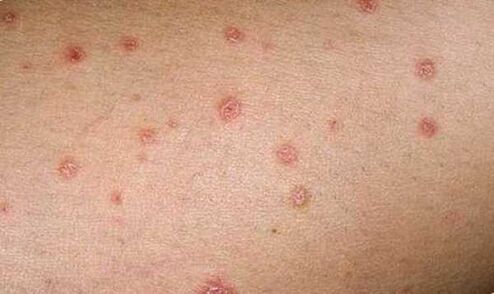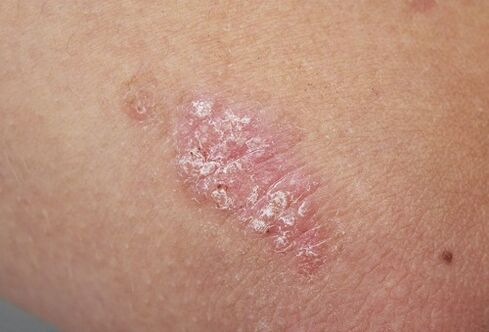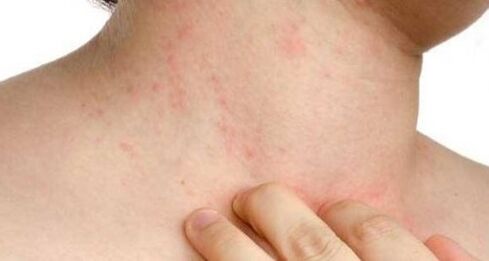A chronic disease lasts a long time, sometimes for years - the almost complete disappearance of signs of pathology can be replaced by a period of relapse, and then the body is again covered with a rash. These are the characteristic symptoms of skin psoriasis. It is necessary to know everything about the disease, including what psoriasis looks like in the initial phase, since the rapid detection and treatment of the disease depends on it.

Causes of the disease
The main factors in the development of the disease are a genetic predisposition transmitted from parents and close relatives, and a weakened immune system, which cannot cope with its functions.
This is a non-infectious lesion of the skin, so do not be afraid to get infected through close contact with sick people. Another thing is when an ailment that causes unpleasant, painful sensations and itching is accompanied by scratching. Through microscopic wounds and damage to the epidermis, any infection quickly enters the bloodstream and a person becomes infected.
In medicine, there are many known causes that can lead to illness:
- Pathologies of the endocrine organs, entailing hormonal changes;
- Regular stresses, strong experiences and shocks lead to the same disturbances;
- Improper food, lack of nutrients, minerals and vitamins can provoke psoriasis;
- Low immunity, weakened due to bad habits, deficiency of vitamin D3 and silicon, nervous shocks, frequent colds and hypothermia;
- Unfavorable living conditions and climate;
- Violation of metabolic processes, in particular, in the layers of the skin, because of what exactly it takes the hit of the disease in the form of an itchy rash.
Medications taken can also lead to anomalies, if they have a long course and a strong effect, the body's immunological reaction to allergens can be an aggravating factor. And, of course, the onset of psoriasis is often associated with previous infections that were not completely cured or had serious complications.
The defeat of the disease is of a local and general nature, when the human body represents one continuous crust of sores merged together. In this regard, it is worth considering the stages of psoriasis, since they differ in their course and symptoms.
Types of disease by the nature of the course
The disease develops cyclically - this is a gradual change and increase in typical symptoms.

There are three main stages:
- Progressive psoriasisAre two main stages. During the first, a characteristic rash develops actively, which causes the patient an unpleasant burning sensation, pain, severe itching. As a result, the normal appetite, sleep is disrupted, a person at this moment is prone to irritability, depression, neuroses. The second stage is remission, restoration of the normal appearance and condition of the epidermis, pigmentation spots remain in place of psoriatic sores, slightly darker than the normal skin color. The progressive stage is a typical clinical picture of a chronic disease. When there is no treatment, the rehabilitation periods are short and very soon an exacerbation of the pathology can be expected again;
- Stationary stage of psoriasis- this is a stable condition of the patient, when the symptoms do not disappear, but new papules do not appear either. At the same time, the growth of existing spots, which begin to actively peel off, temporarily stops. The patient cherishes the hope that after peeling, the red plaques raised above the skin will heal and disappear, but this does not happen - after one stratum corneum another appears and so on ad infinitum. At least during the stationary stage of psoriasis, the patient does not feel unbearable itching, leading to scratching and insomnia;
- The last stage- the period of regression. Over a period of time, there is a gradual decrease in the plaque-like scab, the sores heal, clean areas of the epidermis appear between them, until the rash completely disappears, leaving only residual pigmentation of the painful areas.
Psoriasis has a long course. In some patients, complications most often occur in winter and autumn, in others, the sun's rays affect the deterioration of the condition, however, there is a variant of out-of-season exacerbations, when a relapse can occur at any time of the year. In general, several cases of disease progression occur during the year.
To understand how psoriasis begins, it is worth considering its primary signs.
Initial stage: characteristic manifestations
Pathology almost always occurs suddenly, for no apparent reason, although, of course, they exist. The impetus can be a cold, stress at work, mild food poisoning, or an allergic reaction.
Many are interested in how psoriasis manifests itself, because at first a person can mistake small reddish nodules scattered in different parts of the body for an allergic rash. And if it is a pustular appearance, then small bubbles with pus appear on the epidermis, which can be easily confused with urticaria. Moreover, in some cases, the initial stage is accompanied by itching. Therefore, the question of whether psoriasis itches at the initial stage, with this type of skin lesion, can be answered in the affirmative.
The main element of the rash is a flat, slightly raised nodule of pink or red color; this inflammation has a surface layer on which small plates of dry, horny scales are located. A detailed examination shows that at first the stratum corneum are located in the very center of the inflammatory focus, and then grow over the entire surface of the plaque.

The location of the rash is varied - these are the inner and outer bends of the knee, elbow joints, the entire surface of the lower and upper extremities, hands, palms and soles of the feet, groin, gluteal region, back, chest. Elements of the rash tend to appear on the auricles and behind them, cover the skin on the head under the hair, appear on any part of the face, and sometimes on the genitals, especially in men.
Elements of the rash scattered over the body become overgrown with a gray scab in just two or three days. In medicine, this is called a point form of the disease.
Subsequently, the growth of new sores continues, after which they can join and merge into solid areas. A feature of the pathology is that papules can also occur at the site of bruises, other injuries, if the disease begins to progress.
If the appearance of the first inflammation is usually not accompanied by itching, with a progressive course, it becomes painful and then the patient needs to be treated with local hormonal drugs.
Launched psoriasis can bring the patient to a severe physical and mental state.
Plaque growths interfere with walking, sitting, and performing simple human actions. In addition, patients with this ailment are prone to severe nervous and mental illnesses.
Some forms cause destruction of blood vessels, nerve endings, joints, psoriatic lesions can destroy even bone tissue. Without treatment, a person can be brought to disability, so you need to go to the doctor in case of early manifestations of the disease.
Diagnostics and treatment
Before conducting laboratory and instrumental examinations, the doctor is faced with the task of obtaining a complete description of the patient's complaints, studying the causes of the disease, and tracing the genetic relationship with the onset of pathology.
To determine the disease, there is a certain functional test. If there are three main elements (psoriatic trio), characterized by the presence of a stearin spot, a layer of pink cells and bleeding caused by vascular damage, then an accurate diagnosis can already be made.

In the future, procedures such as:
- Biopsy of samples of the affected skin tissue;
- Bacteriological culture to determine the infection in the inflammation focus;
- Clinical blood test for the concentration of leukocytes;
- Immunological test for allergic predisposition;
- X-ray, ultrasound, determining the state of internal organs, articular cavities, bones;
- Differential diagnosis helps to exclude diseases such as syphilis, seborrheic eczema, pink lichen, rheumatism, and other disorders with similar symptoms.
In most cases, it is impossible to get rid of the pathology permanently, but earlier treatment can help reduce the number and quality of relapses, up to long periods of regression.
Complex treatment offers:
- Conservative therapy with steroid and non-steroidal drugs, psychotropic drugs that alleviate the patient's depression;
- Also, agents are prescribed to reduce the allergic response of the immune system, which allows you to eliminate edema, itching, and reduce the course of the inflammatory process;
- Hormonal drugs are prescribed to suppress inflammation and relieve pain in severe forms;
- Without fail, the patient must take vitamin products that help increase the body's defenses;
- Topically applied ointments and creams to relieve the patient's well-being based on medicinal herbs, and sometimes hormones.
People suffering from chronic skin disease need to lead a healthy lifestyle, give up inappropriate nutrition, and carry out water procedures every day to avoid complications of the disease. And of course, for successful rehabilitation, you need to see a doctor as early as possible.























